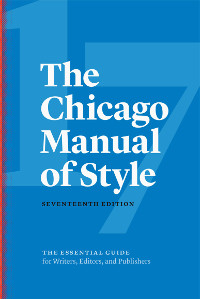It’s essential to have a quality reference guide to refer to during the preparation of a nonfiction manuscript. (It’s less important for fiction since poetic license is often exercised.) Throughout the trade book publishing world, the essential resource for authors, editors, and publishers is The Chicago Manual of Style. It is available in print as well as online for a subscription fee. This is the style guide we follow when working on a manuscript. Read all about it:
The Chicago Manual of Style, 17th Edition
The Chicago Manual of Style is the authoritative, trusted source that writers, editors, and publishers turn to for guidance on style and process. For the seventeenth edition, every aspect of coverage has been reconsidered to reflect how publishing professionals work today. Though processes may change, the Manual continues to offer clear, well-considered advice, as it has for more than a century.
Of course it’s okay to deviate from Chicago’s preferred styles, but the key is being aware that you are deviating from a certain standard and being sure that you have a good reason for doing so. If there’s no good reason, it’s best to stick with the tried-and-true.
Chicago recommends Merriam-Webster’s Collegiate Dictionary, Eleventh Edition, as its main dictionary resource. This dictionary is available online at www.webster.com at no charge.
Another great resource is The Copyeditor’s Handbook: A Guide for Book Publishing and Corporate Communications by Amy Einsohn.


Recent Comments